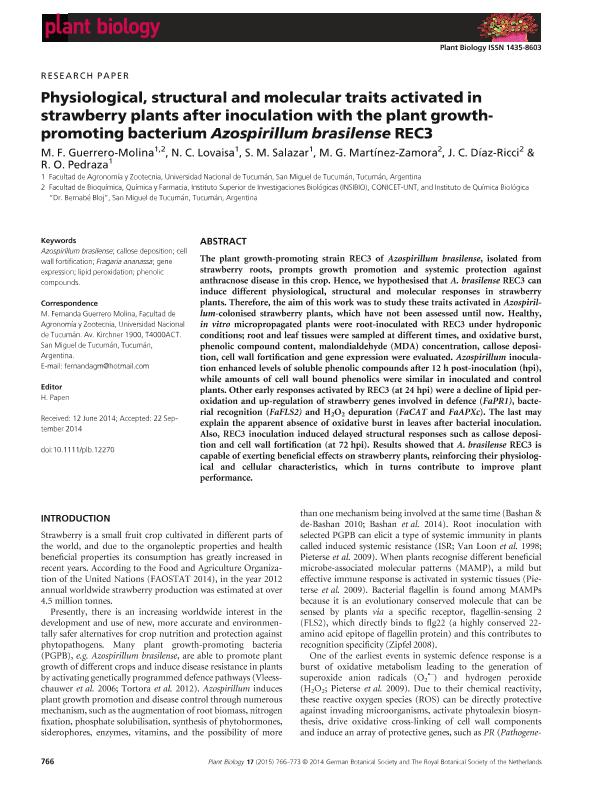Mostrar el registro sencillo del ítem
dc.contributor.author
Guerrero Molina, María Fernanda

dc.contributor.author
Lovaisa, Nadia Carolina

dc.contributor.author
Salazar, Sergio Miguel

dc.contributor.author
Martinez Zamora, Martin Gustavo

dc.contributor.author
Diaz Ricci, Juan Carlos

dc.contributor.author
Pedraza, Raúl Osvaldo

dc.date.available
2018-06-08T23:33:41Z
dc.date.issued
2015-05
dc.identifier.citation
Guerrero Molina, María Fernanda; Lovaisa, Nadia Carolina; Salazar, Sergio Miguel; Martinez Zamora, Martin Gustavo; Diaz Ricci, Juan Carlos; et al.; Physiological, structural and molecular traits activated in strawberry plants after inoculation with the plant growth-promoting bacterium Azospirillum brasilense REC3; Wiley Blackwell Publishing, Inc; Plant Biology; 17; 3; 5-2015; 766-773
dc.identifier.issn
1435-8603
dc.identifier.uri
http://hdl.handle.net/11336/48039
dc.description.abstract
The plant growth‐promoting strain REC3 of Azospirillum brasilense, isolated from strawberry roots, prompts growth promotion and systemic protection against anthracnose disease in this crop. Hence, we hypothesised that A. brasilense REC3 can induce different physiological, structural and molecular responses in strawberry plants. Therefore, the aim of this work was to study these traits activated in Azospirillum‐colonised strawberry plants, which have not been assessed until now. Healthy, in vitro micropropagated plants were root‐inoculated with REC3 under hydroponic conditions; root and leaf tissues were sampled at different times, and oxidative burst, phenolic compound content, malondialdehyde (MDA) concentration, callose deposition, cell wall fortification and gene expression were evaluated. Azospirillum inoculation enhanced levels of soluble phenolic compounds after 12 h post‐inoculation (hpi), while amounts of cell wall bound phenolics were similar in inoculated and control plants. Other early responses activated by REC3 (at 24 hpi) were a decline of lipid peroxidation and up‐regulation of strawberry genes involved in defence (FaPR1), bacterial recognition (FaFLS2) and H2O2 depuration (FaCAT and FaAPXc). The last may explain the apparent absence of oxidative burst in leaves after bacterial inoculation. Also, REC3 inoculation induced delayed structural responses such as callose deposition and cell wall fortification (at 72 hpi). Results showed that A. brasilense REC3 is capable of exerting beneficial effects on strawberry plants, reinforcing their physiological and cellular characteristics, which in turns contribute to improve plant performance.
dc.format
application/pdf
dc.language.iso
eng
dc.publisher
Wiley Blackwell Publishing, Inc

dc.rights
info:eu-repo/semantics/openAccess
dc.rights.uri
https://creativecommons.org/licenses/by-nc-sa/2.5/ar/
dc.subject
Azospirillum Brasilense
dc.subject
Callose Depositions
dc.subject
Cell-Wall Fortificatioiin
dc.subject
Lipid Peroxidation
dc.subject
Phenolic Compounds
dc.subject
Gene Expression
dc.subject
Fragaria Ananassa
dc.subject.classification
Otras Biotecnología Agropecuaria

dc.subject.classification
Biotecnología Agropecuaria

dc.subject.classification
CIENCIAS AGRÍCOLAS

dc.title
Physiological, structural and molecular traits activated in strawberry plants after inoculation with the plant growth-promoting bacterium Azospirillum brasilense REC3
dc.type
info:eu-repo/semantics/article
dc.type
info:ar-repo/semantics/artículo
dc.type
info:eu-repo/semantics/publishedVersion
dc.date.updated
2018-05-04T21:42:21Z
dc.journal.volume
17
dc.journal.number
3
dc.journal.pagination
766-773
dc.journal.pais
Reino Unido

dc.journal.ciudad
Londres
dc.description.fil
Fil: Guerrero Molina, María Fernanda. Consejo Nacional de Investigaciones Científicas y Técnicas. Centro Científico Tecnológico Conicet - Tucumán. Instituto Superior de Investigaciones Biológicas. Universidad Nacional de Tucumán. Instituto Superior de Investigaciones Biológicas; Argentina. Universidad Nacional de Tucumán. Facultad de Bioquímica, Química y Farmacia. Instituto de Química Biológica; Argentina. Universidad Nacional de Tucumán. Facultad de Agronomía y Zootecnia; Argentina
dc.description.fil
Fil: Lovaisa, Nadia Carolina. Consejo Nacional de Investigaciones Científicas y Técnicas. Centro Científico Tecnológico Conicet - Tucumán. Instituto Superior de Investigaciones Biológicas. Universidad Nacional de Tucumán. Instituto Superior de Investigaciones Biológicas; Argentina. Universidad Nacional de Tucumán. Facultad de Agronomía y Zootecnia; Argentina
dc.description.fil
Fil: Salazar, Sergio Miguel. Universidad Nacional de Tucumán. Facultad de Agronomía y Zootecnia; Argentina
dc.description.fil
Fil: Martinez Zamora, Martin Gustavo. Consejo Nacional de Investigaciones Científicas y Técnicas. Centro Científico Tecnológico Conicet - Tucumán. Instituto Superior de Investigaciones Biológicas. Universidad Nacional de Tucumán. Instituto Superior de Investigaciones Biológicas; Argentina. Universidad Nacional de Tucumán. Facultad de Bioquímica, Química y Farmacia. Instituto de Química Biológica; Argentina
dc.description.fil
Fil: Diaz Ricci, Juan Carlos. Consejo Nacional de Investigaciones Científicas y Técnicas. Centro Científico Tecnológico Conicet - Tucumán. Instituto Superior de Investigaciones Biológicas. Universidad Nacional de Tucumán. Instituto Superior de Investigaciones Biológicas; Argentina. Universidad Nacional de Tucumán. Facultad de Bioquímica, Química y Farmacia. Instituto de Química Biológica; Argentina
dc.description.fil
Fil: Pedraza, Raúl Osvaldo. Consejo Nacional de Investigaciones Científicas y Técnicas. Centro Científico Tecnológico Conicet - Tucumán; Argentina. Universidad Nacional de Tucumán. Facultad de Agronomía y Zootecnia. Departamento de Ecología. Cátedra de Microbiología Agrícola; Argentina
dc.journal.title
Plant Biology

dc.relation.alternativeid
info:eu-repo/semantics/altIdentifier/url/http://onlinelibrary.wiley.com/doi/10.1111/plb.12270/abstract
dc.relation.alternativeid
info:eu-repo/semantics/altIdentifier/doi/https://dx.doi.org/10.1111/plb.12270
Archivos asociados
